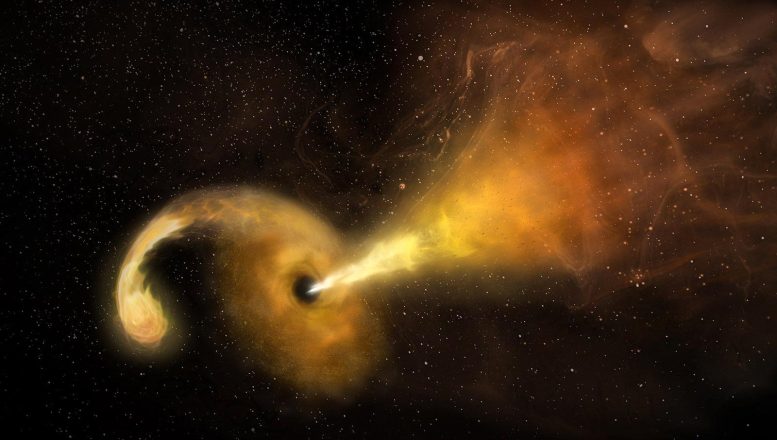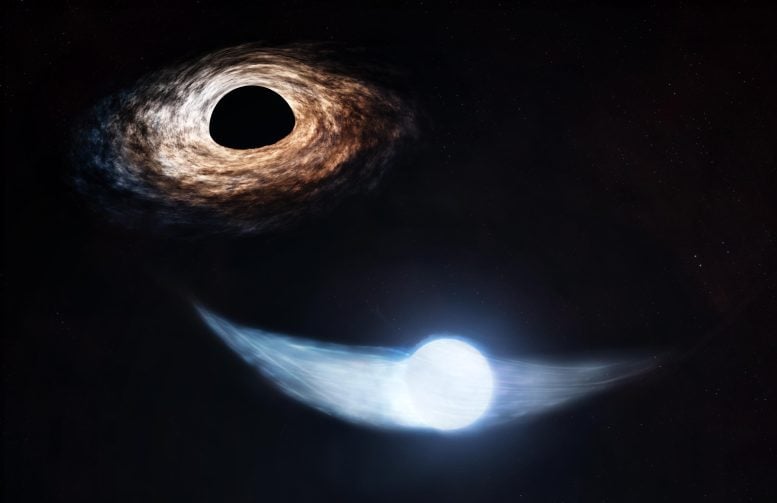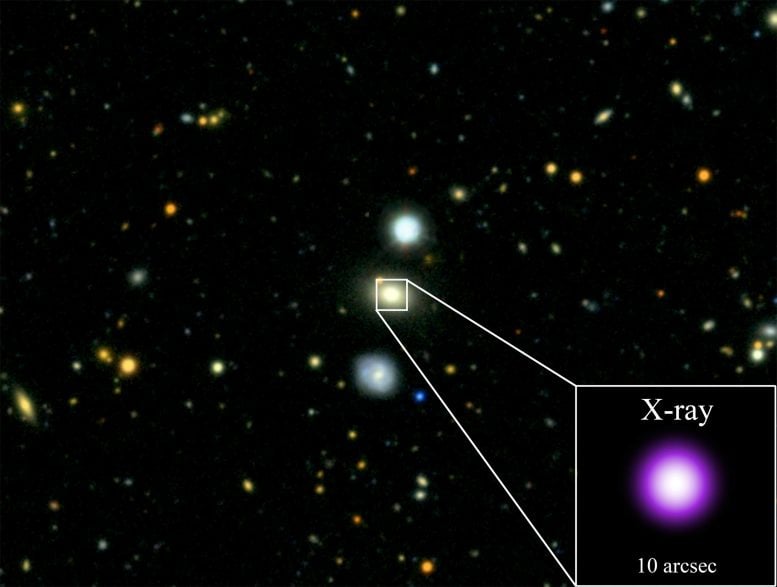Cosmic Clockwork Decoded in Black Hole Feeding Patterns – World Pakistan


Black holes, traditionally elusive and invisible, are being unveiled through the observation of tidal disruption events (TDEs) where stars are violently destroyed, generating luminous flares observable across vast distances.
The dramatic dimming of a light source ~ 860 million light-years away from Earth confirms the accuracy of a detailed model developed by a team of astrophysicists from Syracuse University, MIT, and the Space Telescope Science Institute.
Understanding Black Holes Through TDEs
Powerful telescopes like NASA’s Hubble, James Webb, and Chandra X-ray Observatory provide scientists a window into deep space to probe the physics of black holes. While one might wonder how you can “see” a black hole, which famously absorbs all light, this is made possible by tidal disruption events (TDEs) – where a star is destroyed by a supermassive black hole and can fuel a “luminous accretion flare.” With luminosities thousands of billions of times brighter than the Sun, accretion events enable astrophysicists to study supermassive black holes (SMBHs) at cosmological distances.
TDEs occur when a star is violently ripped apart by a black hole’s immense gravitational field. As the star is shredded, its remnants are transformed into a stream of debris that rains back down onto the black hole to form a very hot, very bright disk of material swirling around the black hole, called an accretion disc. Scientists can study these to make direct observations of TDEs, and compare those to theoretical models to relate observations to physical properties of disrupted stars and their disrupting black holes.

Innovations in Black Hole Research
A team of physicists from Syracuse University, MIT, and the Space Telescope Science Institute used detailed modeling to predict the brightening and dimming of AT2018fyk, which is a repeating partial TDE, meaning the high-density core of the star survived the gravitational interaction with the SMBH, allowing it to orbit the black hole and be shredded more than once.
The model predicted that AT2018fyk would “dim” in August 2023, a forecast which was confirmed when the source went dark last summer, providing evidence that their model delivers a new way to probe the physics of black holes. Their results were published in The Astrophysical Journal Letters.

A High Energy Source
Thanks to incredibly detailed extragalactic surveys, scientists are monitoring more coming and going light sources than ever before. Surveys pan entire hemispheres in search of sudden brightening or dimming of sources, which tells researchers that something has changed. Unlike the telescope in your living room that can only focus visible light, telescopes such as Chandra can detect light sources in what’s referred to as the X-ray spectrum emitted from material that is millions of degrees in temperature.
Visible light and X-rays are both forms of electromagnetic radiation, but X-rays have shorter wavelengths and more energy. Similar to the way in which your stove becomes “red hot” after you turn it on, the gas comprising a disc “glows” at different temperatures, with the hottest material closest to the black hole. However, instead of radiating its energy at optical wavelengths visible to the eye, the hottest gas in an accretion disc emits in the X-ray spectrum. These are the same X-rays used by doctors to image your bones and that can pass through soft tissue, and because of this relative transparency, the detectors used by NASA X-ray telescopes are specifically designed to detect this high-energy radiation.’
A Repeat Performance
In January 2023, a team of physicists, including Eric Coughlin, a professor at Syracuse University’s Department of Physics, Dheeraj R. “DJ” Pasham, a research scientist at MIT, and Thomas Wevers, a Fellow at the Space Telescope Science Institute, published a paper in The Astrophysical Journal Letters that proposed a detailed model for a repeating partial TDE. Their results were the first to map a star’s surprising return orbit about a supermassive black hole – revealing new information about one of the cosmos’ most extreme environments.
The team based their study on a TDE known as AT2018fyk (AT stands for “Astrophysical Transient”), where a star was proposed to be captured by a SMBH through an exchange process known as “Hills capture.” Originally part of a binary system (two stars that orbit one another under their mutual gravitational attraction), one of the stars was hypothesized to have been captured by the gravitational field of the black hole and the other (non-captured) star was ejected from the center of the galaxy at speeds comparable to ~ 1000 km/s.
Once bound to the SMBH, the star powering the emission from AT2018fyk has been repeatedly stripped of its outer envelope each time it passes through its point of closest approach with the black hole. The stripped outer layers of the star form the bright accretion disk, which researchers can study using X-Ray and Ultraviolet /Optical telescopes that observe light from distant galaxies.
While TDEs are usually “once-and-done” because the extreme gravitational field of the SMBH destroys the star, meaning that the SMBH fades back into darkness following the accretion flare, AT2018fyk offered the unique opportunity to probe a repeating partial TDE.
The research team has used a trio of telescopes to make the initial and follow-up detections: Swift and Chandra, both operated by NASA, and XMM-Newton, which is a European mission. First observed in 2018, AT2018fyk is ~ 860 million light-years away, meaning that because of the time it takes light to travel, it happened in “real-time” ~ 860 million years ago.
The team used detailed modeling to forecast that the light source would abruptly disappear around August 2023 and brighten again when the freshly stripped material accretes onto the black hole in 2025.
Probing the Future: Predictions and Implications
Confirming the accuracy of their model, the team reported an X-ray drop in flux over a span of two months, starting on August 14, 2023. This sudden change can be interpreted as the second emission shutoff.
“The observed emission shutoff shows that our model and assumptions are viable, and suggests that we are really seeing a star being slowly devoured by a distant and very massive black hole,” says Coughlin. “In our paper last year, we used constraints from the initial outburst, dimming, and rebrightening to predict that AT2018fyk should display a sudden and rapid dimming in August of 2023, if the star survived the second encounter that fueled the second brightening.”
The fact that the system displayed this predicted shutoff therefore implies several distinctions about the star and the black hole:
- the star survived its second encounter with the black hole;
- the rate of return of stripped debris to the black hole is tightly coupled to the brightness of AT2018fyk;
- and the orbital period of the star about the black hole is ~ 1300 days, or about 3.5 years.
The second cutoff implies that another rebrightening should happen between May and August of 2025, and if the star survived the second encounter, a third shutoff is predicted to occur between January and July of 2027.
As for whether we can count on seeing a rebrightening in 2025, Coughlin says the detection of a second cutoff implies that the star has had more mass freshly stripped, which should return to the black hole to produce a third brightening.
“The only uncertainty is in the peak of the emission,” he says. “The second re-brightened peak was considerably dimmer than the first, and it is, unfortunately, possible that the third outburst will be dimmer still. This is the only thing that would limit the detectability of this third outburst.”
Coughlin notes that this model signifies an exciting new way to study the incredibly rare occurrences of repeating partial TDEs, which are believed to take place once every million years in a given galaxy. To date, he says scientists have encountered only four to five systems that display this behavior.
“With the advent of improved detection technology uncovering more repeating partial TDEs, we anticipate that this model will be an essential tool for scientists in identifying these discoveries,” he says.
Reference: “A Potential Second Shutoff from AT2018fyk: An Updated Orbital Ephemeris of the Surviving Star under the Repeating Partial Tidal Disruption Event Paradigm” by Dheeraj Pasham, E. R. Coughlin, M. Guolo, T. Wevers, C. J. Nixon, Jason T. Hinkle and A. Bandopadhyay, 14 August 2024, The Astrophysical Journal Letters.
DOI: 10.3847/2041-8213/ad57b3
Source link



